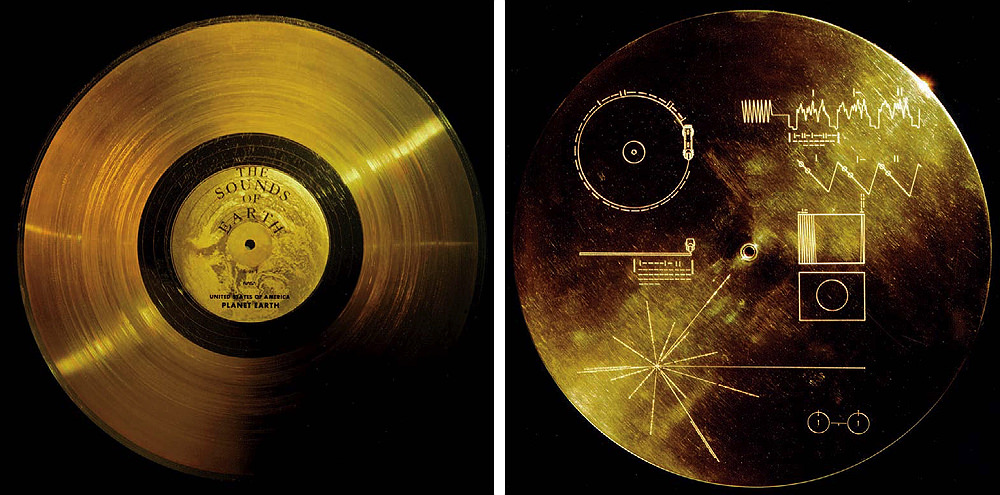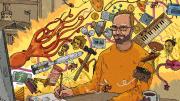In the summer of 1977, NASA rocketed two spacecraft out of Earth’s orbit. Their mission: explore the unexplored. NASA had already been to the moon; with Voyager 1 and Voyager 2, its Jet Propulsion Laboratory wanted to push beyond the outer planets and the Sun’s gravitational pull, and into interstellar space. By 2030, drained of electricity, both ships will lose contact with Earth.
But that may not be the last time they’re heard. Affixed to each Voyager is a golden record. The Golden Record.
Some know the Golden Record as a collection, basically, of Earth’s greatest hits. It contains selections from Bach’s Brandenburg Concerto No. 2 in F Major and his third Partita for solo violin. It has the Queen of the Night’s aria from Mozart’s The Magic Flute, the first movement of Beethoven’s Fifth Symphony, and the thundering sacrificial dance from Stravinsky’s The Rite of Spring. It features Blind Willie Johnson, Louis Armstrong, and Chuck Berry’s “Johnny B. Goode.”
And before the current conception of “World Music” took hold, NASA scientists searched for and secured selections from across the world. Alongside the Beethoven, Berry, and Bach are Senegalese percussion, rock-’n’-roll gamelan, and Navajo chant. Australian aboriginal songs, Mexican mariachi music, and Georgian choral singing stand beside landmarks of the Western canon.
The Golden Record project remains as massively aspirational today as it was at the time. It will take tens of thousands of years for it to reach planets theoretically capable of sustaining intelligent life. And if other life forms find it, then what? What if they can’t figure out how to play it? What if they don’t have ears?
The Song of Static
To bring together his diverse interests, Peabody professor of music Alexander Rehding—a music theorist and musicologist who has written books on intellectual history, sound studies, and media theory—had to look beyond Earth. The Golden Record, which raises seemingly infinite philosophical, biological, and musical questions, became an ideal research project for the academic who will never be called a specialist. He believes everything he studies falls within the realm of academic music—it’s just that his conception of music is a bit broader than the field is used to.
“I have a very short attention span,” he says, sitting in his office. “I get bored very easily.” But watching him bounce from topic to topic, each presented with extraordinary enthusiasm, it’s hard to imagine Rehding bored. After welcoming me into his office, he directs my attention to the gramophone sitting on his table. The music department gave it to him as a photo-shoot prop and told him to keep it, though he finds the “keep” ambiguous. “I don’t think I can take it home,” he says, bending over to inspect the machine at eye-level. “I think I can have it here.”

Instructions drawn on the Golden Record’s cover (right) detail how to play it. A pulsar map on the case's lower left shows Earth’s location.
Images from NASA
He’s been thinking of purchasing a box of used wax cylinders—the gramophone’s chosen recording medium—on eBay, just to see if any of them work. Most don’t, he says, but soon he’s clicking through YouTube, searching for audio of a famous wax-cylinder recording of Johannes Brahms performing his Hungarian Dance Number One. The sound is rough and garbled: the sonic equivalent of reading from a crumpled piece of paper. Rehding stares at the screen with a serene focus, chin resting on his right hand, picking out the music from the static.
To Rehding, though, the static is music, too. Just like Brahms symphonies or Beyoncé singles, it’s made up of frequencies that are, in this case, within the human auditory range. And just like orchestral motifs in Brahms or the chorus of a Beyoncé song, the static contains elements that repeat over time; crescendos and decrescendos coalesce into a steady, crackling hum. Eventually, a sense of rhythm begins to emerge. Not exact quarter notes in a metronome-dictated tempo, but a feeling of organization. And as in any other piece of music, the vibrations begin, and later end. That period of time is organized by frequencies: the song of static.
In his forthcoming book, Music from Earth: Alien Listening and NASA’s Golden Record, Rehding imagines how to analyze music that’s been launched into space and ripped from any semblance of context. Written with co-author Daniel Chua, professor and chair of music at the University of Hong Kong, Music from Earth centers on their proposed “Intergalactic Music Theory of Everything.” The theory provides a new definition of music—one they hope makes as much sense for aliens as it does for humans—and it comes down to frequencies, repetitions, and time. “We need to reduce the idea of music to its most basic components, to bare vibrations,” Rehding wrote in a 2017 edition of Musical Brainfood, an International Musicological Society publication, “and to build it up from there.”
All sounds are made of vibrations—from the tempestuous sonority of Vivaldi’s “Spring” to the joyful hum of a Stevie Wonder harmonica solo. A string or a reed vibrates, waves of pressure travel throughout the air, and particles knock into each other. That’s how sound is created.
Repetition, to Rehding, makes sense of these frequencies. “Imagine a series of clicks that we record,” he says. “When we play them slowly, we hear them as a pulsation of individual clicks, a rhythm. But if we speed up the recording so that the rate is higher than about 20 clicks per second, something interesting happens: the individual pulsations merge into a single tone.” This change occurs at 20 Hertz [Hz]—the human “auditory threshold”—where repeated clicks become pitch. “Our hearing only has this one auditory threshold,” Rehding explains. “But we could extend this principle further: to phrases, to formal sections of a piece. We could think of them as very, very slow rhythms, rhythms-at-large, another kind of frequency….That’s the nuts and bolts of the theory. That’s how temporality is shaped.”
By reducing music to its most basic components, Rehding hopes to create a portal into music analysis that anyone can enter. That includes aliens. If and when they listen to the Golden Record, they’ll have only the recordings themselves. Alongside Beethoven’s Fifth, they won’t have access to elucidatory music analysis from Henrich Schenker. As they listen to The Rite of Spring, they won’t be privy to Allen Forte’s set-pitch-class theory. To supply a theoretical framework for each recording on the Golden Record, NASA would have had to attach a Golden Textbook. It’s a level of context that would overwhelm most aliens (and most humans).
“Music Theory Is for Music Theorists”
Music theory is complex. Becoming versed in “sonata theory” and the musical backbone behind Mozart, Haydn, and Beethoven can take years of training in tuning and tonal systems, harmony, rhythm, notation, and the gamut of performance practices. By the time twentieth-century composer Arnold Schoenberg’s music gets involved, a new framework is needed. Most people, no matter their love for music, struggle to comprehend the technical explanations behind it, much less contribute to its study. “[M]usic theory is for music theorists,” Rehding and Chua write. “It has fallen into an academic narcissism that would be quite beautiful were it not so boring for everyone else peering into the discipline.”
But music theory wasn’t always thought of in this way. Pythagoras believed that planets and heavenly bodies rang at different frequencies based on their distances from each other, and grouped the study of music with that of arithmetic, geometry, and astronomy. According to myth, he even created his own mode of music theory. Drawn to the clanging of hammers from a blacksmith’s forge, he noticed a smattering of consonances and dissonances. He measured the hammers and noticed that the ratios of weight between them determined the music he heard. The ratio of two to one produced a sonorous octave, while the ratio nine to eight produced a clanging dissonance. “And so for these hammers,” Rehding writes, “Pythagoras distilled a speculative music theory of everything: the non-human world is composed of numbers according to harmonious proportions. The entire universe suddenly became music technology.”
No humans made music in this myth. The blacksmith was not consciously producing a pleasing chord progression. Instead, the hammer was the agent of music theory, and the blacksmith an instrument, unknowingly taking part in a world of vibrations.
Rehding and Chua don’t entirely buy into Pythagoras’s music theory, but they resonate with its premise: the world, even without human ears, is filled with music. “The environment itself is all ears; it is abundant with life, tingling with receptors, and vibrant with oscillators,” they write. “Humans may form part of this network, but music’s identity is not isolated by humans.”
When Rehding reduces music to frequencies, it’s not really a reduction. “I’m teaching a seminar on Beethoven...,” he says. “I don’t think of it as an either/or. I think of it more as a both/and.”
When Rehding reduces music to frequencies, it’s not really a reduction. He likes conventional music theory and has spent his entire life studying it. “I mean, I’m teaching a seminar on Beethoven next semester, I’m teaching sonata form,” he says. “I don’t think of it as an either/or. I think of it more as a both/and.”
But by focusing on frequencies, repetition, and time, he believes music can make sense of concepts that other fields struggle with—like time. “We’re really bad at time. It’s just something that our vocabulary is not very well developed for,” he says. “Whenever we talk about time, we employ spatial metaphors. We say, ‘I have a big meeting ahead.’ Or, ‘The holiday season is approaching us.’”
Music makes sense of time temporally. A repeating sound, whether a radiator shaking or a passage of sixteenth notes, vibrates in the time-space continuum. The repetition could stop after just two repetitions, but for that duration, time was neatly packaged and described.
By thinking of music as an organizer of time, Rehding makes the study of music relevant to other fields. “Some of the very fundamental aspects of the philosophy of time are that time doesn’t exist in itself,” he explains. “For us, it only exists in terms of events that we can experience.” When proposing a philosophical definition of time, music, defined very simply, can be helpful.
Rehding takes particular interest in music that lasts a very long time. In John Cage’s “As Slow as Possible,” for instance, the composer directs performers to abide by 65 written instructions as slowly as they can. Performances typically last between 20 and 70 minutes, but some run much longer. One performance at a church in Halberstadt, Germany, began in 2001 and will continue for 639 years, ending in 2640.
In that case, music’s focus shifts beyond humans. No amount of highly technical musical preparation can help someone play a piece for 639 years. It forces people to think beyond the music itself—and past the duration of a human life. “None of us are going to be around by the time the piece ends,” Rehding says. “And so this idea that we listen to a piece from beginning to end, and then somehow understand something about the form, is simply not an option.”
Humans generally don’t do well with big issues, like climate change, that involve very slow changes over time, he says. But music can help demonstrate that an event hundreds or thousands of years in the future is contingent on something happening now. As he notes, with a smile, “Thinking beyond the next legislative cycle would be really helpful for all of us.”
Similarly, a music theory based on frequencies encourages a new perspective on human perception. Between the frequencies of 20 Hz and 20,000 Hz, people hear notes. The oboe’s “A” that tunes an orchestra resonates at around 440 Hz; the piano’s lowest note sounds at about 25 Hz. Thirty thousand or so hair cells in the human ear, each trained to pick up certain frequencies, help reduce related frequencies into a fundamental pitch. When someone presses the piano’s middle C, most hear just that note, even though a series of higher frequencies vibrate simultaneously.

Whales, flies, and rhesus macaques make sense of frequencies in distinct ways. For each, the music on the Golden Record would sound unique—and different from how most humans experience it.
Photographs from iStock
But if music is defined as repeating vibrations, that means an entire musical palette exists outside human perception. The study of music then pushes into biology. It is almost assured that aliens, with distinct biological features and a unique atmosphere, will not hear The Golden Record the way humans do. Even on Earth, close evolutionary relatives like rhesus macaques don’t share the human ability to fuse frequencies into single notes. To their ears, each note of a simple piano melody might sound like a polyphonous hodgepodge. Octopodes, which perceive sounds between roughly 400 and 1000 Hz, can’t hear the entire upper range of a piano keyboard; funky bass lines below 400 Hz might be nothing more than a rhythmic pulsation. For humans to make make sense of whale song, the “singing” must be filtered through a hydrophone that transduces sound waves into electrical voltage. The “humanized” version would seem alien to whales.
And different species have different perceptions of time. In one thought experiment, Karl Ernst von Baer, a Baltic German explorer and scientist, theorized that for a fruit fly with a lifetime one-thousandth the average human’s, each second would be a major event. Music humans hear as fast and high-pitched could be incredibly low and slow for this fruit fly; on the Golden Record, Edda Moser’s stratospheric soprano range on the Queen of the Night aria might come across as a basso profundo. The three-minute run-time for the fruit fly would be the human equivalent of 48 hours.
Rehding knows how unlikely it is that an alien, light years away, will grab the Golden Record, pop it into a record player, and appreciate the album’s novel curation. “I don’t want to suggest that I’m out there looking for, you know, little green men,” he explains. “I think I’ve mentioned this every time I start talking to a stranger about this project.” But by shaking up prevailing assumptions about music and trying to understand how a 13-eared, 20-foot-tall being might perceive Bach, he sees a path toward a better understanding of how music works here on Earth. “[E]ven as we turn our attention to distant planets,” he says, “the benefits we may reap from this post-human musicology are ultimately geocentric and distinctly human.”
Down the Musical Rabbit Hole
Rehding was born in Hamburg into what he describes as a “wholly unmusical” family. He remembers his parents signing him up for a variety of activities, but the only two that stand out were handball (traumatic) and piano lessons (fun). He sometimes spent hours at the keyboard—not practicing in any focused way, just playing through pieces. When his school orchestra needed a trombone player, he volunteered to learn that instrument, too.
Still, as the son of a dentist and a psychotherapist, he thought he, too, would work somewhere in medicine. But after a 20-month, post-high-school stint as a conscientious objector, working in a home-care center, he decided that the field wasn’t for him.
Unlike many of his peers, Rehding had never taken a year abroad during high school, so he thought college would be a good time to do so. His original intention was to study Russian, his favorite high-school subject, but he wanted to study in England. “And so I decided, well, you know, music isn’t so bad,” he says, laughing.
His plan seemed unlikely to succeed. Despite learning to play instruments and studying music as a high-school elective, he hadn’t done much to distinguish himself in the musical realm. Looking for advising at the British Council Office in Hamburg, he informed a counselor of his intention to apply to Cambridge. “She looked at me up and down and said, ‘You?’” he recalls. “And that was her advising. That was it.”
Rehding applied anyway and found himself in a daunting process with semi-hostile interviewers. “They’re kind of mean,” he says. “They kind of push you until you wave the red flag.” For a small committee, he performed a piano selection, briefly studied and discussed a Mozart quartet, and transcribed four-part harmonies by ear. “In retrospect, I was incredibly unprepared,” he says. The interview went on for what felt like forever, though he estimates it was closer to an hour. He was convinced that that would be it.
It was not; he received an acceptance in the mail, and in 1991 enrolled in Queens College. The undergraduate curriculum, he says, was “incredibly traditional and rigorous and narrow….You only study music. You don’t do anything else.” He dutifully completed counterpoint exercises and studied keyboard harmony and ear training and focused primarily on the nineteenth-century orchestral repertoire—a safely traditional field. But he couldn’t help venturing outside. For his undergraduate thesis, he wrote about György Ligeti’s 1982 Trio for Violin, Horn, and Piano and how the innovative composer had leapfrogged the then-stylish avant-garde.
He returned to Germany intending to continue his studies there, but met with resistance. “I waved my certificate at German authorities and they just smiled sweetly and said, ‘We don’t recognize foreign degrees,’” he recalls. He decided to return to Cambridge to complete a Ph.D.
It was then the floodgates opened. With a foundation in tonal and harmonic theory established, Rehding explored areas he had never thought of, including the relationship between music and literary history and theory. He read Foucalt, Derrida, and Adorno, and, for his master’s thesis, researched the work of Ernst Krenek and Paul Hindemith, composers who combined baroque counterpoint and twentieth-century atonal techniques. He wrote his doctoral thesis on Hugo Riemann, a then-obscure German music theorist.
John Deathridge, who advised that dissertation, remembers his student as unafraid of straying from the traditional Cambridge path. Rehding, he says, can find clarity and consequence in the obscure, drawing interest from outside the field. “I’m actually a nuts-and-bolts music person myself, because I’m a conductor and I can teach harmony and counterpoint,” Deathridge says. “But obviously, if you want music to have any kind of intellectual or cultural meaning, you have to get beyond that. Not everybody listening to rock music will know about V7 chords.” Rehding’s music research is for the initiates and uninitiates alike.
After 10 years at Cambridge, with undergraduate, master’s, doctoral, and postdoctoral programs under his belt, Rehding was ready to move on. “It’s incredibly beautiful,” he says, “and incredibly small and boring.” He applied to and was accepted for postdoctoral work at the University of Pennsylvania, and then at Princeton—neither of which required him to be in a formal music department.
Penn was a culture shock, but a good one. He was particularly fascinated by Philadelphia’s grid system (uncommon in Europe) and American gun culture, and glad that academics discussed their work over meals; at Cambridge, there was an unspoken tradition that work is not to be discussed. “And so since that’s basically all you do, there isn’t much to talk about other than the weather or the quality of food in the dining hall,” Rehding says.
At Princeton, he grew fascinated with media theory and became particularly invested in the work of German literary scholar and media theorist Friedrich Kittler, who studied how different technologies store, transform, and transfer data. “Sound itself has always been an obscure object of desire and fascination,” says John Durham Peters, professor of English and film and media studies at Yale (who has connected with Rehding over a common interest in Kittler). “It seems to embody the central problem that media scholars are always after, which is time and attention and how things come into being.” A record floating in interstellar space, for instance, is not just an object, but packaged information from a different time and place.
In 2003, Rehding accepted a junior-faculty position at Harvard, expecting to be sent on his way when the question of tenure arose. He was granted tenure just two years later—the first successful internal case in the music department in more than 40 years.
His success comes down partly to his propensity for rabbit holes. “I get sort of obsessed with ideas and I start reading around. And there is a process of discovery that is somewhat random,” he explains. “One thing leads to another, and at some point I end up stuck on something. Maybe that’s whale song, maybe that’s something else.” An interest in the intellectual development of music theory began with his thesis on Riemann. By 2009, Rehding was on sabbatical, studying intensive Ancient Greek (his seventh language) at Wellesley, trying to understand better how Grecian music theory of that era differed from its modern version. His obsession with media theory led to an investigation of the physical mechanism of the modern siren, and how short blasts of air at different frequencies could produce different patterns of pitch and rhythm.
Rehding “channels a lot of ideas and connects a lot of people....He’s come to understand that you can’t just have a very self-enclosed system of music that is just for the initiates.”
But these aren’t private rabbit holes to investigate alone. He’s worked with physicists on sirens and with biologists on whale songs. In one paper, he provides a neuroscientific explanation of experiences of beauty, aided by his neuroscientist husband, Bevil Conway. “That’s why I call him a bit of a switchboard,” says Chua, who was Rehding’s classmate at Cambridge. “He channels a lot of ideas and connects a lot of people….He’s come to understand that you can’t just have a very self-enclosed system of music that is just for the initiates.”
When Rehding helped redesign the undergraduate music concentration for fall semester of 2017, as co-chair of the curricular review committee, it was this openness that he was trying to achieve, he says. The department eliminated the general theory requirement, instead requiring two tutorials—Music 97a: “Thinking about Music,” and Music 97b: “Critical Listening”—and a tutorial in which to write a thesis or work on a performance or composition project. The decision was controversial, sparking strong reactions, and harshly worded blog posts, from those across the music-theory world who thought the new program tossed aside academic rigor.
Rehding, though, doesn’t think the changes decreased rigor; he thinks they increased options: inviting people to contribute to the study of music who might not otherwise consider it. Students who aimed to be classical composers would still be guided toward intensive theory courses, but others could find a distinct path. “I don’t think we’re taking anything away from anyone if we broaden out,” he says.
A Future in Frequencies
In late March, Rehding was sitting at home, forced away from Harvard by the coronavirus, trying to answer the unexpectedly difficult question of what he’s been listening to lately.
“I have some Taiwanese traditional music from the 1940s,” he says, chuckling under his breath. “I have some socialist children’s songs from the 1970s—from my childhood.” Also lying around: electronic remixes of music on the Golden Record, pieces by contemporary German composer Helmut Lachenmann, Schmelzer violin sonatas from the seventeenth century, jazz from colleague Vijay Iyer, Rosenblatt professor of the arts. “I have listened to each of these in recent weeks,” he says. “Sometimes purposeful, sometimes less. It’s not very systematic.”
Such is his approach to almost everything—an approach especially distinct in the rarified world of music theory. Seeking out physicists, philosophers, media theorists, and NASA project managers in his quest to make sense of the Golden Record, he seeks only to add, never to take away. To Rehding, imagining an interstellar frequency-making machine filled with loops, cycles, folds, and oscillations landing in the tentacles of an alien life-form is a generative exercise. He believes that music can help people think about their collective future—a future measured in frequencies.
He isn’t suggesting a departure from tonal harmony or a dismissal of Beethoven. And he doesn’t think humans should listen to human music as aliens would have to, hopelessly without context. But Rehding has always found clarity in the obscure. By pushing to the edge of a highly specialized discipline, and into interstellar space, he imagines a more universal theory—one that resonates with aliens and humans alike.
“It always comes down to that fundamental question,” Rehding says. “There is this strange thing, music, that fascinates us. Why is there music? What’s it for? Why do we love it so much? I think that’s the ultimate question that we still don’t have a very good answer to.”









